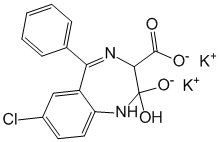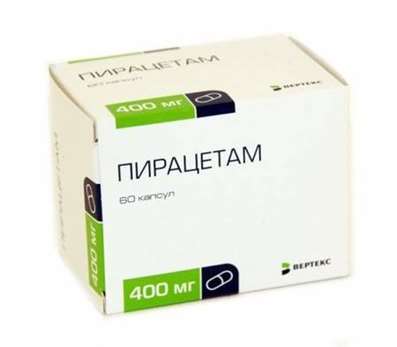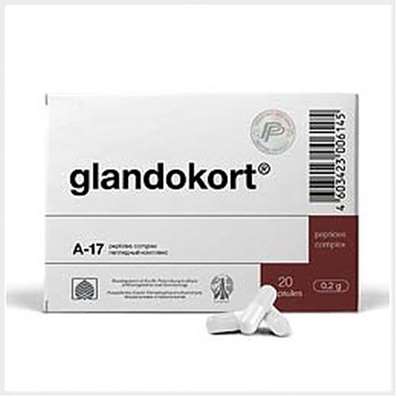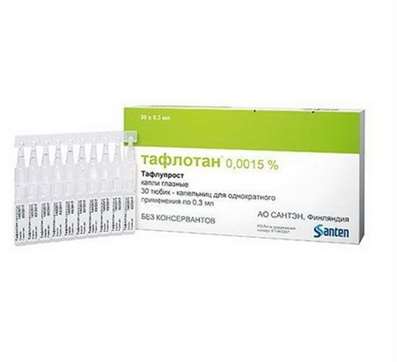Dipotassium clorazepate - Active Substances. Instruction and Application, Dosage
23 Dec 2016
Name: Dipotassium clorazepate

The Latin name of the substance Cyanocobalamin
Dikalii clorazepas (genus. Dikalii clorazepatis)
chemical nameComplex 7-Chloro-2,3-dihydro-2-oxo-5-phenyl-1H-1,4-benzodiazepin-3-carboxylic acid with potassium hydroxide (1: 1)
Formula - C16H11ClK2N2O4
Therapeutic agents of Dipotassium clorazepate: anxiolytics
The nosological classification (ICD-10)
D51 Vitamin-B12-deficiency anemia
D61 Other aplastic anemiaF10.3 abstinence
F41.1 Generalized anxiety disorder
F48.0 Neurasthenia
F51.0 Insomnia inorganic etiology
F95 Teaks
G40.1 localized (focal) (partial) symptomatic epilepsy and epileptic syndromes with simple partial seizures
G40.2 localized (focal) (partial) symptomatic epilepsy and epileptic syndromes with complex partial seizures
CAS code - 57109-90-7
Characteristics substance Dipotassium clorazepate
Anxiolytic from the group of benzodiazepines. The powder is white or light-yellow, almost odorless. Very soluble in water, very slightly soluble in ethanol, practically insoluble in organic solvents. Aqueous solutions - transparent, pale yellow, are alkaline, unstable.
Pharmacology
Mode of action - anxiolytic, anticonvulsant.
Associated with specific benzodiazepine receptors (cerebral cortex, amygdala, hippocampus, hypothalamus, cerebellum, striatum, spinal cord) and increases the sensitivity of GABA receptors to mediator, increasing the braking effect of GABA in the CNS.
After ingestion converted into nordiazepam (dezmetildiazepam) and in this form quickly and adequately absorbed in the intestine and circulated in the systemic circulation. Nordiazepama Cmax in plasma is reached after 30-120 minutes. The equilibrium concentration is usually reached after 5 days in the blood - 2 weeks. Nordiazepam characterized by high plasma protein binding (97-98%), T1 / 2 of plasma is 40-50 hours, enters the breast milk. Nordiazepam further metabolized in the liver by hydroxylation. Predominantly excreted in the urine mainly as conjugated oxazepam (gidroksinordiazepama-3) and small amounts of p-conjugated gidroksinordiazepama. With the reappointment of the accumulation of active metabolites significantly.
It refers to the long-acting benzodiazepines. It has a long depressing effect on the central nervous system. It has strong anxiolytic effects. Muscle relaxant and sedative effects are mild. It reduces levels of anxiety, excitement. It relieves the symptoms of acute alcohol withdrawal.
Experimental studies in animals (rat, monkey) showed a significant difference in the doses producing anxiolytic, sedative and toxic effects. Thus, rats cancellation reflex prevented by ingestion of 10 mg / kg, the sedative effect develops at a dose of 32 mg / kg, LD50 - 1320 mg / kg. In monkeys, aggressive behavior is inhibited at doses of 0.25 mg / kg, sedation (ataxia) develops at 7.5 mg / kg, LD50 greater than 1600 mg / kg, but is not defined as at higher doses appears emetic effect.
In toxicity studies in dogs (21 animals) treated with dipotassium clorazepate orally at doses up to 75 mg / kg for 22 months was associated with marked changes taking drugs in the liver (weight reduction, cholestasis with minimal hepatocellular damage).
In toxicity studies in monkeys (18 animals) treated with dipotassium clorazepate orally at doses of 3-36 mg / kg / day for 52 weeks, the females at high doses has been observed associated with taking medication tendency to reduce the number of leukocytes, while the total number of leukocytes remained in the normal range. Violations of the function or structure of the liver (and other organs) have been identified.
Studies fertility, reproduction, teratogenicity in rodents (rats and rabbits) showed that taking dipotassium clorazepate orally at doses up to 150 mg / kg (rat) and 15 mg / kg (rabbits) did not induce the development of abnormalities in the fetus does not affect fertility and reproductive capacity in adult animals.
In experiments on animals (dogs and rabbits) observed the occurrence of dependence, manifested in the development of seizures with abrupt cancellation or reduction of the dose drugs; This syndrome in dogs was stopped by introducing dipotassium clorazepate.
Application of the substance Dipotassium clorazepate
All kinds of anxiety disorders (treatment of anxiety disorders or for the short-term relief of anxiety symptoms), withdrawal syndrome in alcoholic patients (symptomatic treatment), partial seizures, teak (in children).
Contraindications
Hypersensitivity, respiratory failure, angle-closure glaucoma, pregnancy (especially I trimester), breast-feeding.
Restrictions to application
Depressive states, psychotic reactions, infants, children up to 9 years (safety and efficacy have not been determined).
Pregnancy and breast-feeding
Contraindicated during pregnancy (especially in I trimester). At the time of treatment should stop breastfeeding.
Side effects of substance Dipotassium clorazepate
From the nervous system and sensory organs: drowsiness, dizziness, irritability, blurred vision, headache, confusion, insomnia, fatigue, ataxia, diplopia, depression, tremors, slurred speech.
From the digestive tract: gastrointestinal complaints, including nausea, vomiting, dry mouth, changes in kidney and liver function tests.
Other: transient skin rash, urogenital disorders, lower garden, a decrease of hematocrit.
With long-term use or high doses - physical and psychological dependence, withdrawal symptoms (convulsions, delirium, tremor, abdominal and muscle cramps, vomiting, sweating, nervousness, insomnia, irritability, diarrhea, memory loss).
Interaction of substance Dipotassium clorazepate
Effects increase (each) alcohol, neuroleptics, barbiturates and other drugs that suppress the central nervous system, peripheral and central muscle relaxants.
Overdose of substance Dipotassium clorazepate
Symptoms: oppression CNS varying degrees of symptoms (from somnolence to coma), inhibition of breathing and heart activity.
Treatment: gastric lavage, induction of vomiting, monitoring vital signs, the use of respiratory and cardiovascular analeptikov. As an antidote can be used by a specific antagonist flumazenil benzodiazepine receptors (in the hospital).
Dosing and Administration of Dipotassium clorazepate Substances
Inside. Dosage and duration of treatment strictly individually adjusted (under medical supervision) depending on the indication, the clinical picture, portability, etc. The average dose for adults -. 30 mg / day (15-60 mg / d), the maximum dose - 90 mg / d. The starting dose for the elderly and debilitated patients - 3.75 mg per night.
The dose for children and duration of treatment are selected individually depending on the age and nature of the disease.
Precautions for Dipotassium clorazepate substance
Be wary of in diseases of the liver and kidneys, children, the elderly and debilitated patients. Patients with drug and alcohol use under the close supervision of a physician.
To prevent the syndrome of cancellation of the dose should be reduced gradually. Not recommended simultaneous reception of oppressive central nervous system. It should not be combined with alcohol intake. In the course of treatment is not recommended to drive vehicles and engage in work that requires attention and quick response. Chronic administration shows a periodic monitoring of peripheral blood and liver function.
special instructions
Anxiety or tension associated with everyday stress usually does not require treatment with an anxiolytic.
Trading names of drugs with working substance Dipotassium clorazepate
Trade Name
Apo Clorazepate
Tranxene

 Cart
Cart





